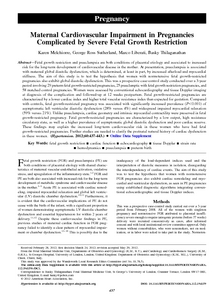Melchiorre, K; Sutherland, GR; Liberati, M; Thilaganathan, B
(2012)
Maternal Cardiovascular Impairment in Pregnancies Complicated by Severe Fetal Growth Restriction.
HYPERTENSION, 60 (2).
437 -443.
ISSN 0194-911X
https://doi.org/10.1161/HYPERTENSIONAHA.112.194159
SGUL Authors: Thilaganathan, Baskaran
![[img]](https://openaccess.sgul.ac.uk/100482/1.hassmallThumbnailVersion/BT_Hyp%20FGR.pdf)  Preview |
|
["document_typename_cannot open `/data/SGUL/sgul/eprints3/archives/sgul/documents/disk0/00/10/04/82/01/BT_Hyp' (No such file or directory)
cannot open `FGR.pdf' (No such file or directory)" not defined]
Published Version
Download (126kB)
| Preview
|
Abstract
Abstract—Fetal growth restriction and preeclampsia are both conditions of placental etiology and associated to increased
risk for the long-term development of cardiovascular disease in the mother. At presentation, preeclampsia is associated with maternal global diastolic dysfunction, which is determined, at least in part, by increased afterload and myocardial stiffness. The aim of this study is to test the hypothesis that women with normotensive fetal growth-restricted pregnancies also exhibit global diastolic dysfunction. This was a prospective case-control study conducted over a 3-year period involving 29 preterm fetal growth-restricted pregnancies, 25 preeclamptic with fetal growth restriction pregnancies, and 58 matched control pregnancies. Women were assessed by conventional echocardiography and tissue Doppler imaging at diagnosis of the complication and followed-up at 12 weeks postpartum. Fetal growth-restricted pregnancies are characterized by a lower cardiac index and higher total vascular resistance index than expected for gestation. Compared with controls, fetal growth-restricted pregnancy was associated with significantly increased prevalence (P�0.001) of asymptomatic left ventricular diastolic dysfunction (28% versus 4%) and widespread impaired myocardial relaxation
(59% versus 21%). Unlike preeclampsia, cardiac geometry and intrinsic myocardial contractility were preserved in fetal
growth-restricted pregnancy. Fetal growth-restricted pregnancies are characterized by a low output, high resistance circulatory state, as well as a higher prevalence of asymptomatic global diastolic dysfunction and poor cardiac reserve. These findings may explain the increased long-term cardiovascular risk in these women who have had fetal growth-restricted pregnancies. Further studies are needed to clarify the postnatal natural history of cardiac dysfunction in these women.
| Item Type: |
Article
|
| Additional Information: |
PubMed ID: 22733460 |
| Keywords: |
Science & Technology, Life Sciences & Biomedicine, Peripheral Vascular Disease, Cardiovascular System & Cardiology, fetal growth restriction, cardiac function, echocardiography, tissue Doppler, strain rate, hemodynamics, preeclampsia, preterm birth, CARDIAC-FUNCTION, DIASTOLIC DYSFUNCTION, RISK-FACTORS, PREECLAMPSIA, WOMEN, HISTORY, DISEASE, RECOMMENDATIONS, INFANTS, WEIGHT, fetal growth restriction, cardiac function, echocardiography, tissue Doppler, strain rate, hemodynamics, preeclampsia, preterm birth |
| Journal or Publication Title: |
HYPERTENSION |
| ISSN: |
0194-911X |
| Related URLs: |
|
| Web of Science ID: |
WOS:000306550900036 |
| Dates: |
| Date |
Event |
| 2012-08-01 |
Published |
|
| URI: |
https://openaccess.sgul.ac.uk/id/eprint/100482 |
| Publisher's version: |
https://doi.org/10.1161/HYPERTENSIONAHA.112.194159 |
Statistics
Item downloaded times since 06 Dec 2012.
Actions (login required)
 |
Edit Item |


